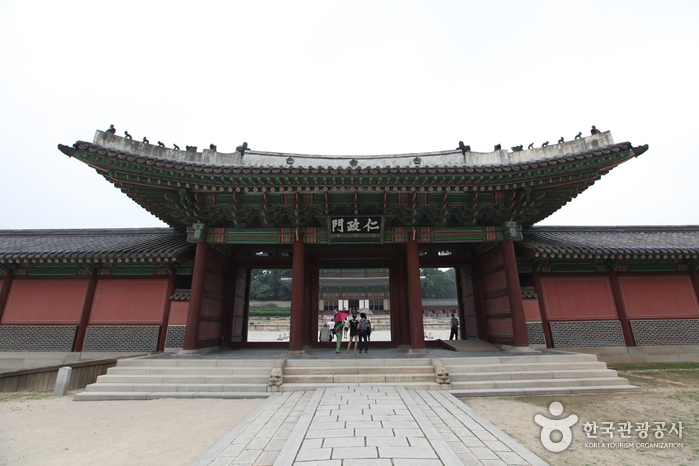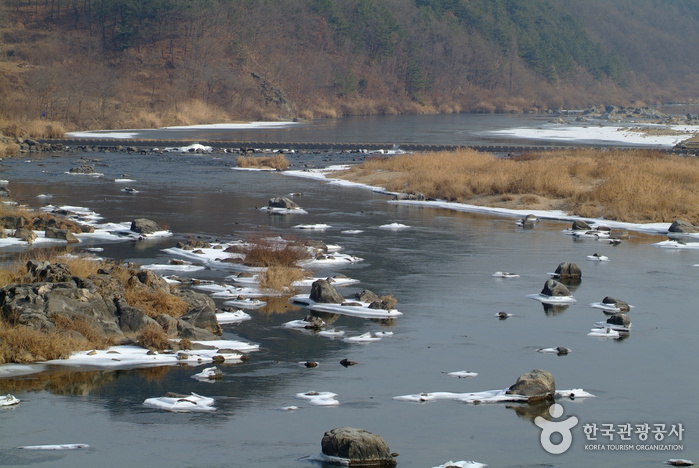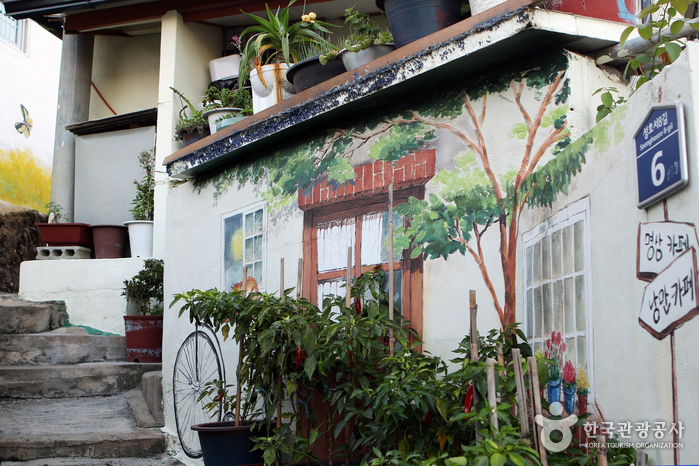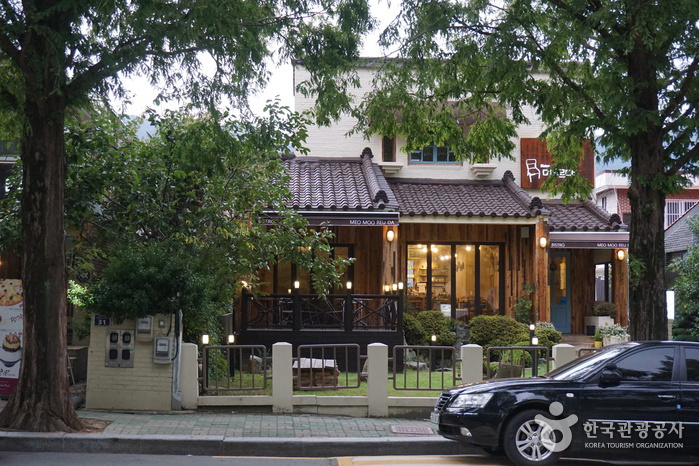Changdeokgung Injeongmun Gate (창덕궁 인정문)
2025-01-14
99, Yulgok-ro, Jongno-gu, Seoul
+82-2-3668-2300
Serving as the main gate of Injeongjeon Hall, Injeongmun Gate was established in 1405 (5th year of King Taejo’s reign during the Joseon dynasty). Later on, the gate was destroyed by multiple fires during the Imjin War (Japanese invasion of Korea in 1592), therefore current form of the establishment displays designs that are more often seen in the late 19th century's. In addition, a lot
of subsidary marks and buildings are removed from the original places and relocated passing the time, however, still remains to represent prestigious ambience.
Injeongmun Gate served as the place for several coronation ceremonies of kings, prince's succession of throne, and many other national affairs celebrated by the royal members who gathered and aligned around this gate.
Seomgang River (Seomgang Resort) (섬강(섬강유원지))
2021-01-28
Munye-ro, Hoengseong-gun, Gangwon-do
+82-33-340-2840
Seomgang River crisscrosses the heart of Hoengseong County, flowing on towards Wonju before eventually joining the Namhangang River. The banks of this river are home to a variety of wild flowers, including bright pink royal azaleas that bloom every spring. Gigantic rocks and pine tree forests on each side complete the view. High on the bluff rests Unamjeong Pavilion, overlooking the river and the unfolding vista. Hoengseong's downtown area starts right after crossing Seomgang River on Heongseonggyo Bridge. Nearby attractions like Hoengseong Sports Complex and local resturants specializing in fish stew also attract more tourists to come after sightseeing.
Gagopa Kkoburang-gil Mural Village (가고파 꼬부랑길 벽화마을)
2020-06-02
15-8, Seonghoseo 7-gil, Masanhappo-gu, Changwon-si, Gyeongsangnam-do
+82-55-220-5690
Masan is made more beautiful by Gagopa Kkoburang-gil Mural Village, a local renovation effort made by Gyeongnam Bank. The village is one of the top photo zones. Walking through the village from Chang-dong, past Burim Market, and on to Seongho-dong mountain neighborhood, the colorful murals will bright every step of the way.
Changwon Garosu-gil (창원 가로수길)
2015-10-15
Yongho-dong, Uichang-gu, Changwon-si, Gyeongsangnam-do
Like Seoul, the city of Changwon also has a romantic promenade called "Garosu-gil," lined with metasequoia trees on each side. The street is filled with a lovely ambience, dotted by small and cozy coffee shops, galleries, and art shops, making it the perfect place for a leisurely walk or a tea-time.
Gochang Munsusa Temple (문수사 (고창))
2024-04-07
135, Chilseong-gil, Gochang-gun, Jeonbuk-do
+82-63-562-0502
Nestled on the slope of Munsusan Mountain (alt. 621 m) in Gochang, Jeollabuk-do and Jangseong, Jeollanam-do, Munsusa Temple is located in the area of a dense mountain ridge to the west of Gosu Kiln Site in Gosu-myeon, and Josan Reservoir. The ridge features clean water and a thick forest that has remained uncontaminated due to its isolated location.
The temple's establishment date is uncertain. The temple houses Daeungjeon Hall (Local Tangible Cultural Heritage No. 51) and Munsujeon Hall (Local Tangible Heritage No. 52), as well as Myeongbujeon and Hansanjeon Halls. Daeungjeon is a small building featuring the unique architecture of gable roofing. Visitors will be fascinated by the temple's scenery, boasting valley waters flowing from dense forests. It is particularly beautiful in fall, when the autumn foliage harmonizes well with the colors of the old temple. The temple grounds are surrounded by a colony of maple trees 100 to 400 years old.
The Forest of Maple Trees at Munsusa Temple, Gochang, was designated in 2005 as Natural Monument No. 463. It covers the area from the entrance of Munsusan Mountain to the entrance of Munsusa Temple with nearly 500 maple trees lining the 80 meter-long path.
Changwon Sangsang-gil Road (상상길 (창원))
2021-01-19
Masanhappo-gu, Changwon-si, Gyeongsangnam-do
+82-55-289-8815
Sangsang-gil Road was created to show the beauty of Korea as imagined by the world. The title of the 150-meter-long road from Buljonggeori Road to Burim Market was given in 2015 after a global internet campaign by Korea Tourism Organization. The road is paved with 23,000 blocks engraved with the names of foreigners in five different colors that represent Korea. The road is also a famous date course with many popular restaurants along the road.
Wolhwawon Garden (월화원)
2024-03-20
399 Dongsuwon-ro, Paldal-gu, Suwon-si, Gyeonggi-do
+82-31-228-4181
Wolhwawon Garden is nestled in Hyowon Park of Suwon and features elements that are heavily influenced by Chinese culture. The garden was established as a result of a special memorandom of agreement (MOU) signed in 2003 between the provincial governments of Gyeonggi-do in Korea and Guangdong in China, in appreciation of the two city's cooperative relationship. It boasts traditional gardens and architecture, man-made lakes and waterfalls designed in the Cantonese style.
Sinseonam Hermitage Rock-carved Bodhisattva in Namsan Mountain of Gyeongju (경주 남산 신선암 마애보살반가상)
2020-04-04
Namsan-dong, Gyeongju-si, Gyeongsangbuk-do
+82-54-779-6100
This 1.4 m-high rock-carved Bodhisattva was carved on the southern rock standing right above Chilburam Rock on Namsan Mountain, which may be regarded as a repository of relics and artifacts including Buddha statues spanning the Three Kingdoms Period to the late Unified Silla Period.
Judging from the three-sided bejeweled crown he’s wearing on his head, this is clearly a Bodhisattva statue. He looks as if he is sitting on a cloud, while the closed eyes on the plump face give the impression that he is lost in deep thought. He seems to be watching mankind from his world above the clouds. He is holding a flower in his right hand and his left hand is held up to his chest as if he is preaching.
His robe is very thin, revealing the curves of the body, and hangs down to the base of the pedestal. The mandorla (Buddhist halo of light), which consists of both the dugwang (light radiating from the head) and hte singwang (light emanating from the Buddha’s body), is also the shrine for the statue, so the image of the Bodhisattva looks more prominent. It is presumed that this rock-carved Bodhisattva was made during the late eighth century during the Unified Silla dynasty.
Hambyeongnu Pavilion (함벽루)
2024-02-02
80 Jukjuk-gil, Hapcheon-gun, Gyeongsangnam-do
+82-55-930-3178
Included in Hapcheon's Eight Scenic Views, Hambyeongnu Pavilion was built in 1321, during the 8th year of Goryeo King Chungsuk by Hapcheon County Lord Kim. The location at the base of Daeyaseong Fortress, the pavilion offers views of Jeongyangho Lake on the Hwanggang River. The pavilion was visited by many poets, with writings from Toegye Yi Hwang, Nammyeong Josil, and Wooam Song Si-yeol hanging from tablets inside, and a rock engraved with "Hambyeongnu" in the handwriting of Song Si-yeol behind the pavilion.
Hambyeongnu is a 3-pillar wide by 2-pillar deep, 2-story pavilion, with an octagonal roof connected with a frame of five parts. The roof of the pavilion is famous in that when it rains, the water drips straight off the eaves and into the river below.
Hapcheon Okgyeseowon Confucian Academy (옥계서원(합천))
2021-03-17
3078-13, Seobu-ro, Hapcheon-gun, Gyeongsangnam-do
+82-55-930-3178
Hapcheon Okgyeseowon Confucian Academy was built to store Yulgok Yi I's writings, "Gyeokmongyogyeol" and "Haedongyeonwonnok." Okgyeseowon was originally founded approximately 4 kilometers away from Hyangok-dong on the third year of Yeongjo's reign (1725) before it was closed due to the seowon abolishment policy by Heungseon Daewongun. On the sixth year of King Gojong’s reign, it was re-built about 200 meters away from the east side of the village. The academy is composed of a lecture hall, Sowonsa, Naesammun, Oesammun, Gwallisa and more.





 English
English
 한국어
한국어 日本語
日本語 中文(简体)
中文(简体) Deutsch
Deutsch Français
Français Español
Español Русский
Русский